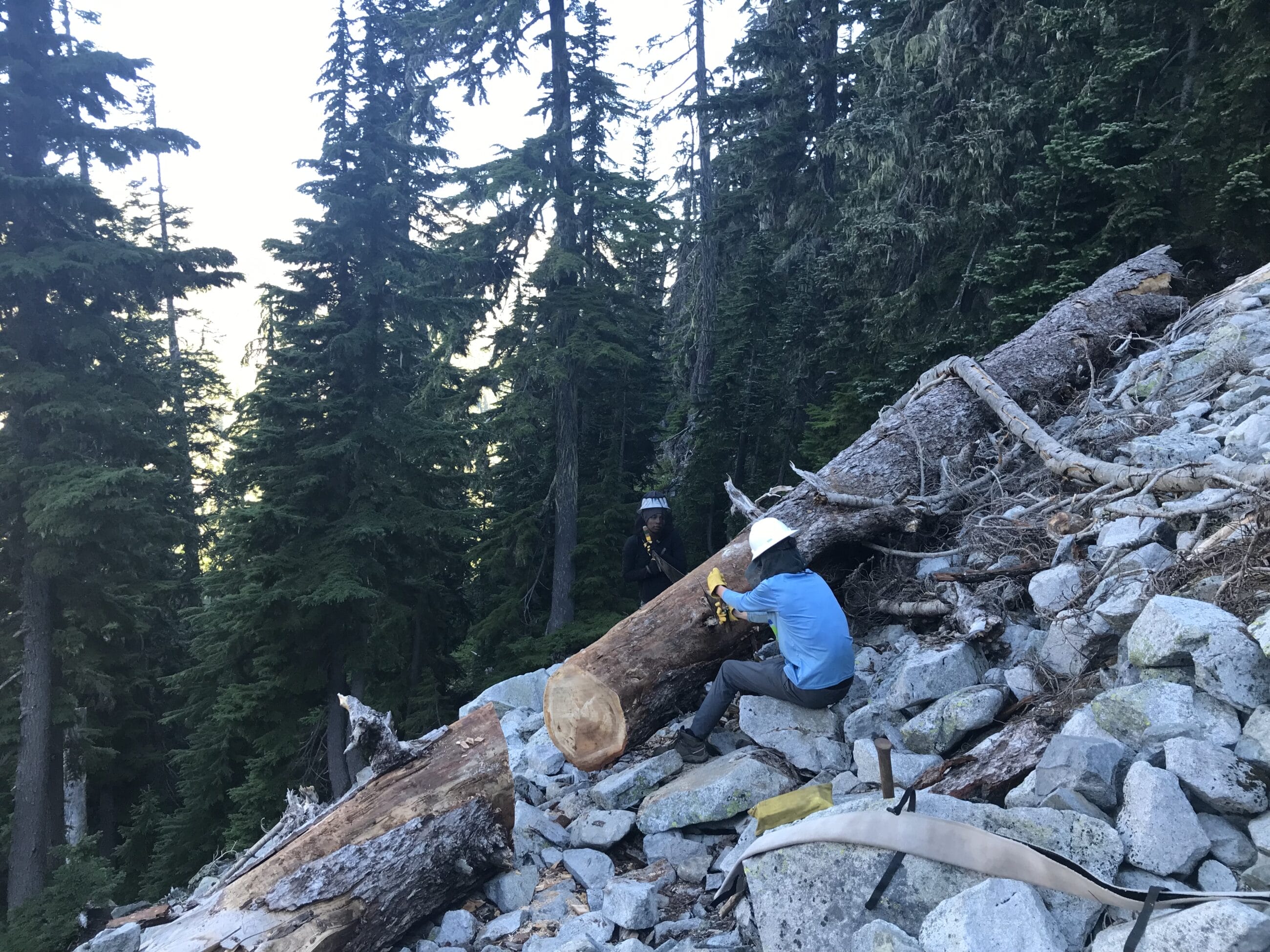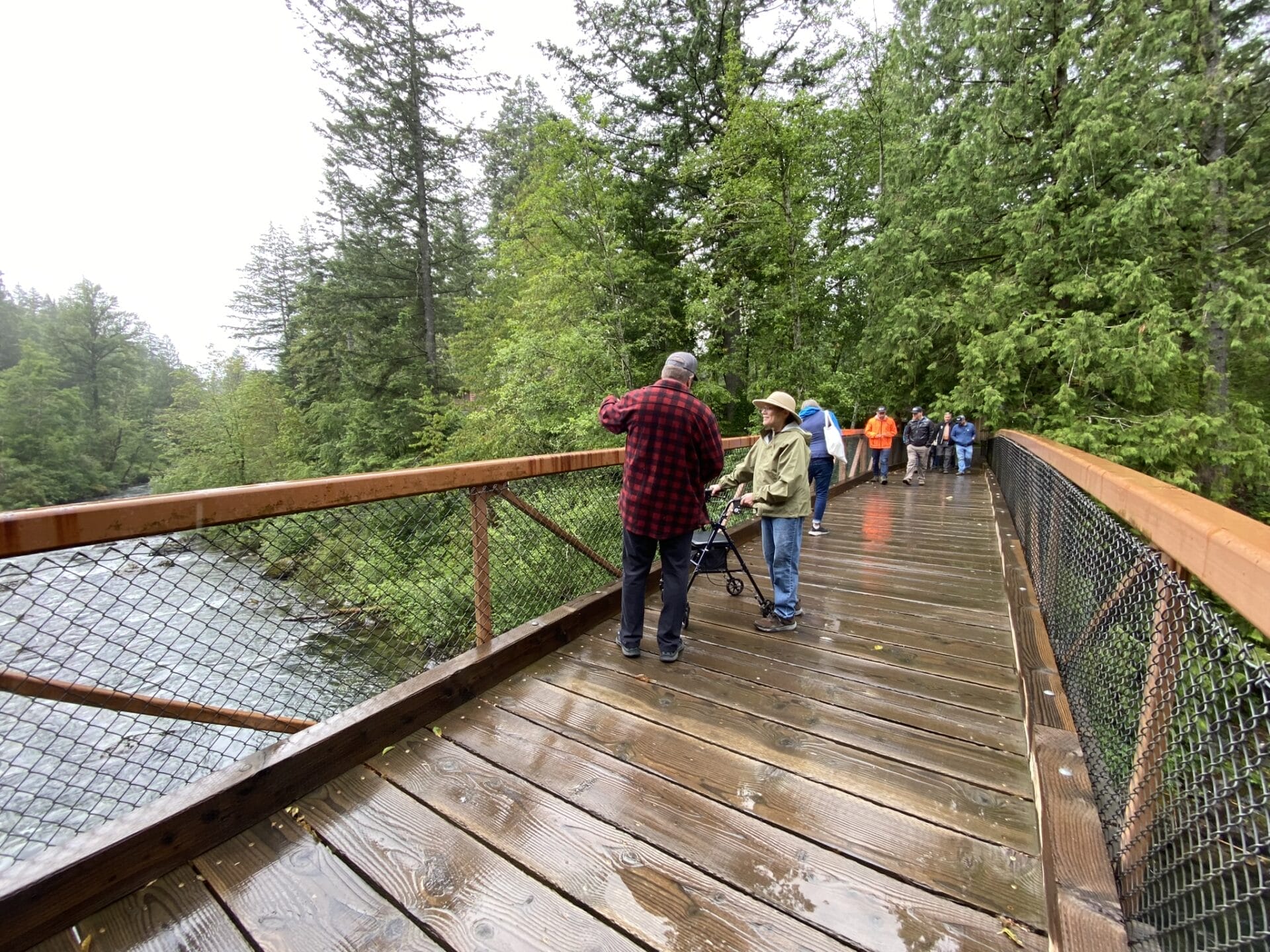What It Takes to Restore 10 Miles of Trail in 8 Days
Over the summer, the Mountains to Sound Greenway Trail Crew completed an eight-day camping trip along the Snow Lake and Rock Creek Trails in the Alpine Lakes Wilderness. Over the course of the spike, we hiked 32 miles and climbed over 8,000 feet in elevation. We removed 17 logs that once obstructed the trail, fixed drainage, and cleared out brush.
Over the course of eight days, we covered around 10 miles of trail. While statistics can convey part of our experience, numbers can never tell the story of how those pathways into the forest re-opened. I offer these daily journals as a way into our time on the trail:
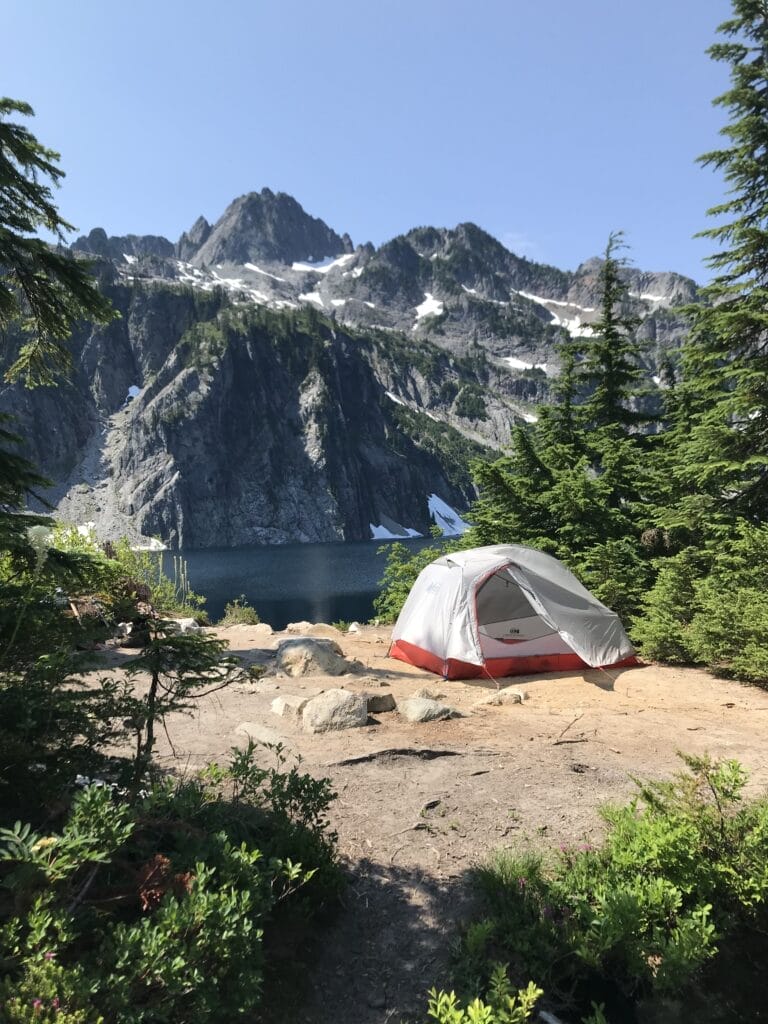
Day 1:
We start hiking at 11:15 am, packs heavier than they’ve ever been, the sun hotter than I’ve ever felt it. Eight days of trail work lie ahead of us, and we can only hope that we are ready. The Alpental ski lifts hang empty and listless, looking out of place above the bright green slopes. The hike to Snow Lake is not long, but it is hot and steep, the rocky trail switchbacking up to a pass before dropping down into the lake basin. Our progress is slow, and the weight of my pack makes my shoulders feel like they are slowly being pulled off of my body. We reach the pass around lunchtime, where we meet up with other Greenway Trust staff who volunteered to carry tools in for us. We rest in the shade for lunch, chatting, laughing, and catching our breath.
Later in the afternoon, we finally arrived at camp. We say goodbye to our tool carriers and settle for the night—pitching tents, filtering water, and hanging our food. The last task is tricky, given the scraggly nature of most of the Mountain Hemlock branches around us, but we make do.

Day 2:
I wake up to the red glow of sunrise on the rocky peak behind Snow Lake, where I realize this might be one of the most beautiful places I’ve ever been. After packing up camp, we begin the two-mile hike up to Gem Lake. This time, we carry our tools—my knees and thighs strain beneath the extra weight. In addition to my personal backpacking gear, eight days’ worth of food, my hardhat, and the large crew first aid kit, I now carry a pair of loppers, a Pulaski, a six-foot long crosscut saw, and a surprisingly heavy bag of plastic wedges. The trail gets more rugged as it climbs, and my leg muscles scream with every step.
We come around a corner to find a blessedly cool patch of air and look up to see a large snow field nestled at the base of a talus slope. Despite the week of 90-degree days ahead of us, this patch will last beyond our time here. We arrive at our camp at Gem Lake (4900 feet in elevation) and repeat the process of setting up camp. After a day and a half, we are finally ready to begin.
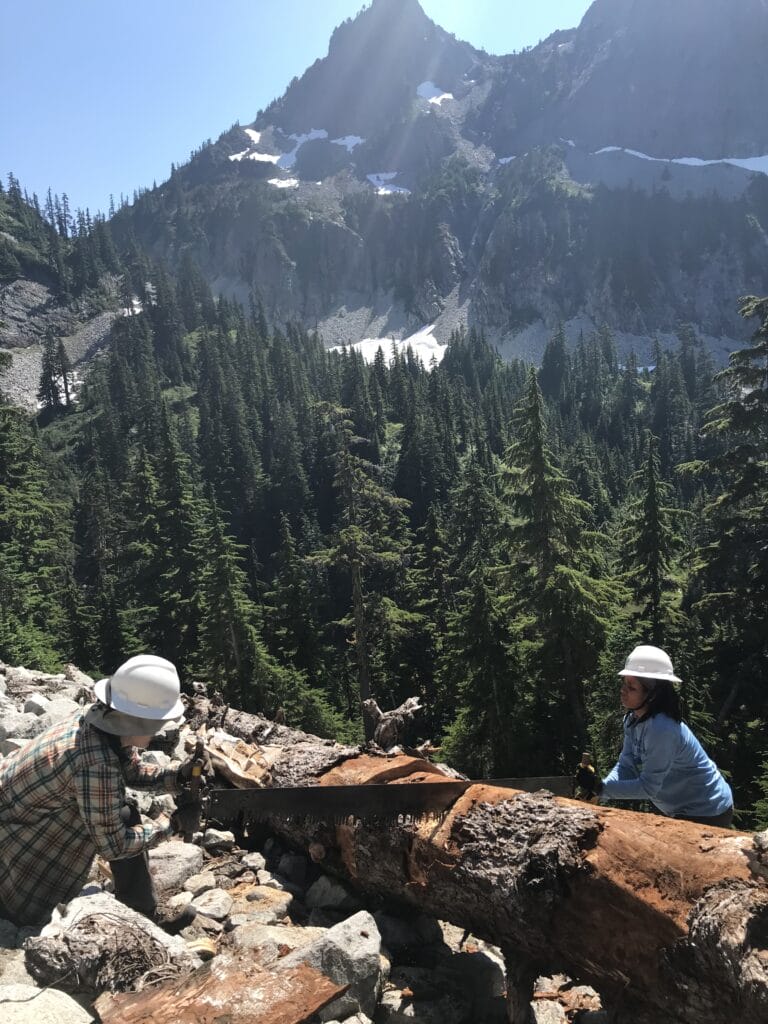

Day 3:
We return to a log wedged diagonally across the trail in a field of rocks. The log refused to cooperate yesterday and we are determined to succeed this time. Mikayla and Sam saw back and forth until I notice the entire log starting to wobble. It is no longer safe to stand downhill so we switch to one-sided sawing. We swap out often, joking how much easier this would be with a chainsaw as we wipe sweat from our brows. Mikayla switches to the axe and suddenly the entire log lets go with a roar. We yell with elation, victory, and terror as the log flies down the slope, knocking rocks loose until hitting a tree. We exchange awed looks until Taylor sighs, “The log is still in the trail”. We look down in disbelief and, sure enough, the log landed perfectly across the trail below us. Sam and I stay to finish the log, slightly defeated yet determined. The cuts go smoothly but it still takes two more hours to clear the log. It is once again dramatic and this time the log lands just off the trail below us. We swap grins. It feels incredible. We return to a log wedged diagonally across the trail in a field of rocks. The log refused to cooperate yesterday, and we are determined to succeed this time. Mikayla and Sam saw back and forth until I notice the entire log starting to wobble. It’s no longer safe to stand downhill so we switch to one-sided sawing. We swap out often, joking about how much easier this would be with a chainsaw as we wipe sweat from our brows. Mikayla switches to the axe, and suddenly the entire log lets go with a roar. We yell with elation, victory, and terror as the log flies down the slope, knocking rocks loose until hitting a tree. We exchange awed looks until Taylor sighs, realizing that “the log is still in the trail.” We looked down in disbelief. Sure enough, the log landed perfectly across the trail below us. Sam and I stay to finish off the log, slightly defeated yet determined. The cuts go smoothly, but it still takes two more hours to clear the log. It is, once again, dramatic. This time, the log lands just off the trail below us. We swap grins. It feels incredible.

Day 4:
We have finally found our groove, removing 12 logs and making it all the way to the end of the trail at Upper Wildcat lake. After testing the waters of the other lakes—one a little too cold, one a little too warm—this lake is just right. The water is clear, and the mountains wrap around a picturesque island. After a much-needed break in the shade, we head back to camp, lopping brush as we go. The thousand-foot climb back to Gem Lake feels harder every day as my feet wear out from the accumulated effort. After making it back to camp, we barely muster the energy to cook dinner. Tomorrow, we will move camp back to Snow Lake. I will miss the throne-like pit toilet looking across lakes and mountains, but I will not miss the swarm of mosquitoes that never seem to sleep.

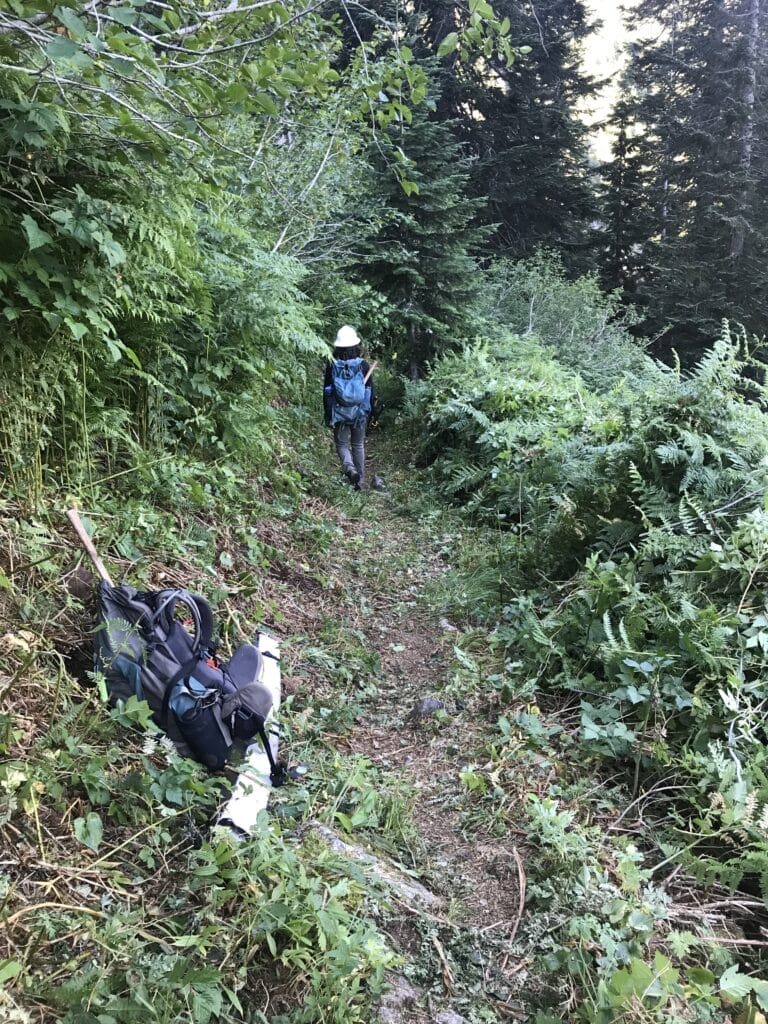
Day 5:
We begin working down the spectacular Rock Creek Trail, which connects to the Middle Fork Trail. Given this summer’s Snow Lake closure, this trail is the only access to the other trails we’ve been working on. At times, the narrow corridor feels less like a trail and more like a series of rocks that someone cleared the brush back from. The views are endless and breathtaking. Across a series of waterfalls that flow from Snow Lake, the water flows a thousand feet down into the Middle Fork of the Snoqualmie. Across the valley, Garfield Mountain spikes into a crystal-clear blue sky, and I compare the mountains before me to the map, realizing that every trail we’ve worked on in the past 6 weeks, can be found in the view before us. We focus on brushing, cutting, and ripping back the overgrowth so that the trail can actually be seen again. The work is tedious at times but immensely satisfying.
Day 6:
The brush gets denser and our progress slows, but morale increases when our supervisor arrives with a new team member, Kiersten. It is both delightful and odd to meet a new crew member like this—with all of us tired and sweaty and very smelly, clinging to a steep rocky slope covered in ferns. We pause work to get to know each other a little bit and rush all over ourselves to eat the fresh cherries they hiked in for us. It is a beautiful day, and it is wild that we have had this place all to ourselves for so long.
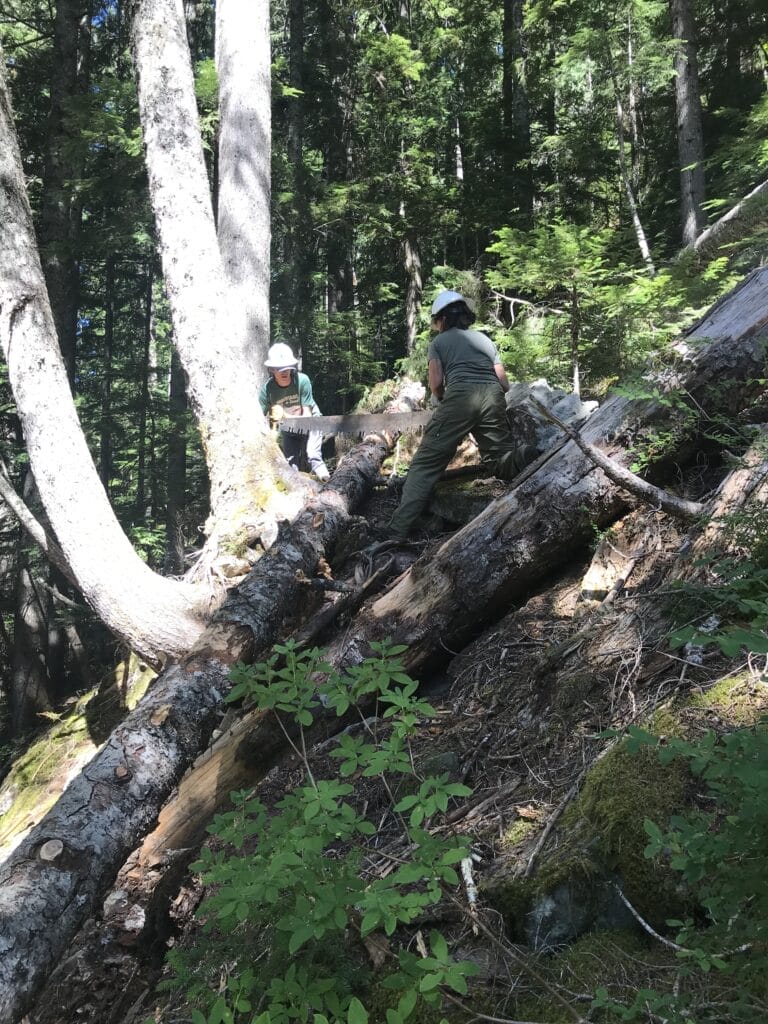
Day 7:
We finally reach shade after working on steep, exposed slopes for two days. Eventually, we find a log across the trail, and I am grateful that I didn’t cart the unwieldy crosscut saw all the way down here for nothing.
We take the opportunity to introduce Kiersten to crosscut sawing. After two successful cuts, we roll the log off of the edge of the trail. Once again, it comes to a stop right on the trail below us. Luckily, this time it is easy to roll the log just a little further and off the trail without having to do any more cuts. We make the long hike back up to camp and I think back fondly to previous spikes when we didn’t have to climb a thousand feet at the end of every day. But then I look up and the cathedral-like beauty of this place stops me in my tracks every time. I concede that it might be worth it.
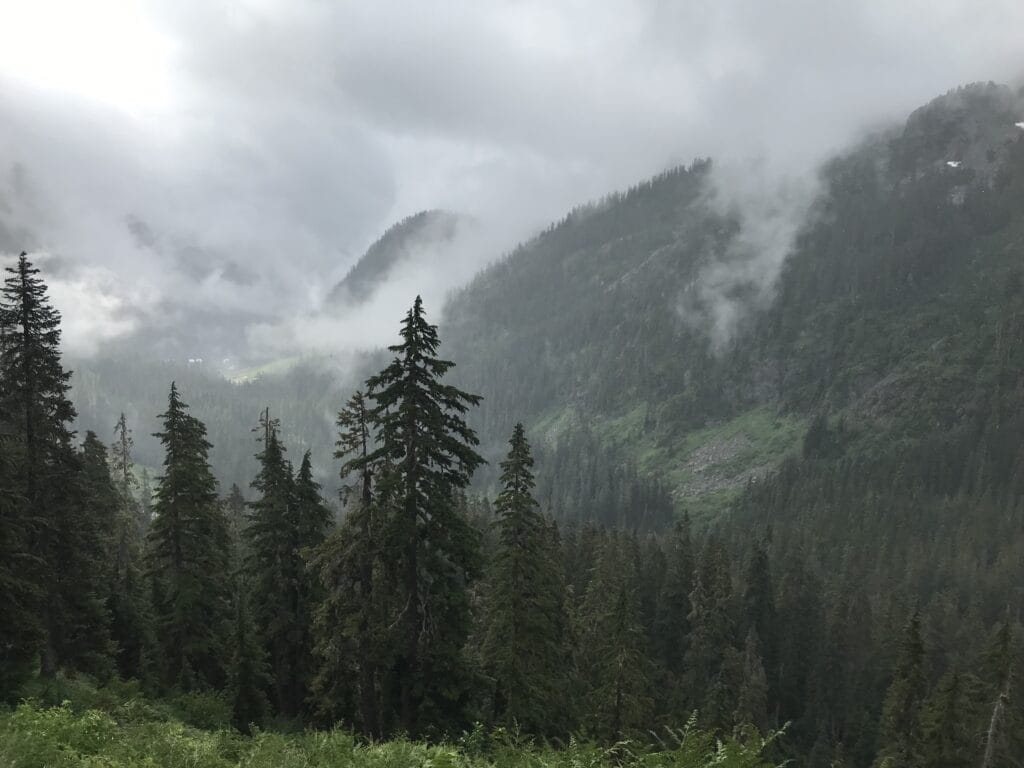
Day 8:
After days of fending off the possibility of dehydration and heat exhaustion, we wake to the sound of rain on our tents. My clothes may have been smelly and dusty the day before, but at least they had been dry. Packing up our wet gear is a miserable affair, but soon enough, we are back on the trail thinking about the dry clean clothes and hot showers in our near future.
We pause at the pass and marvel at the return of cell service. We greet the contractors working on the switchbacks as we pass and carefully climb over the piles of rocks and timber beams that had been delivered by helicopter a few days prior. My lungs are glad for the downhill after so much climbing, but my knees are tender. It feels like we have been out here for months.
In the distance, I see the spindly towers of the ski lift. Then we climb into the truck wet, smelly, and tired, but we made it. I am so proud of what we accomplished and what we overcame in the process. And I look forward to doing it all again next week.

